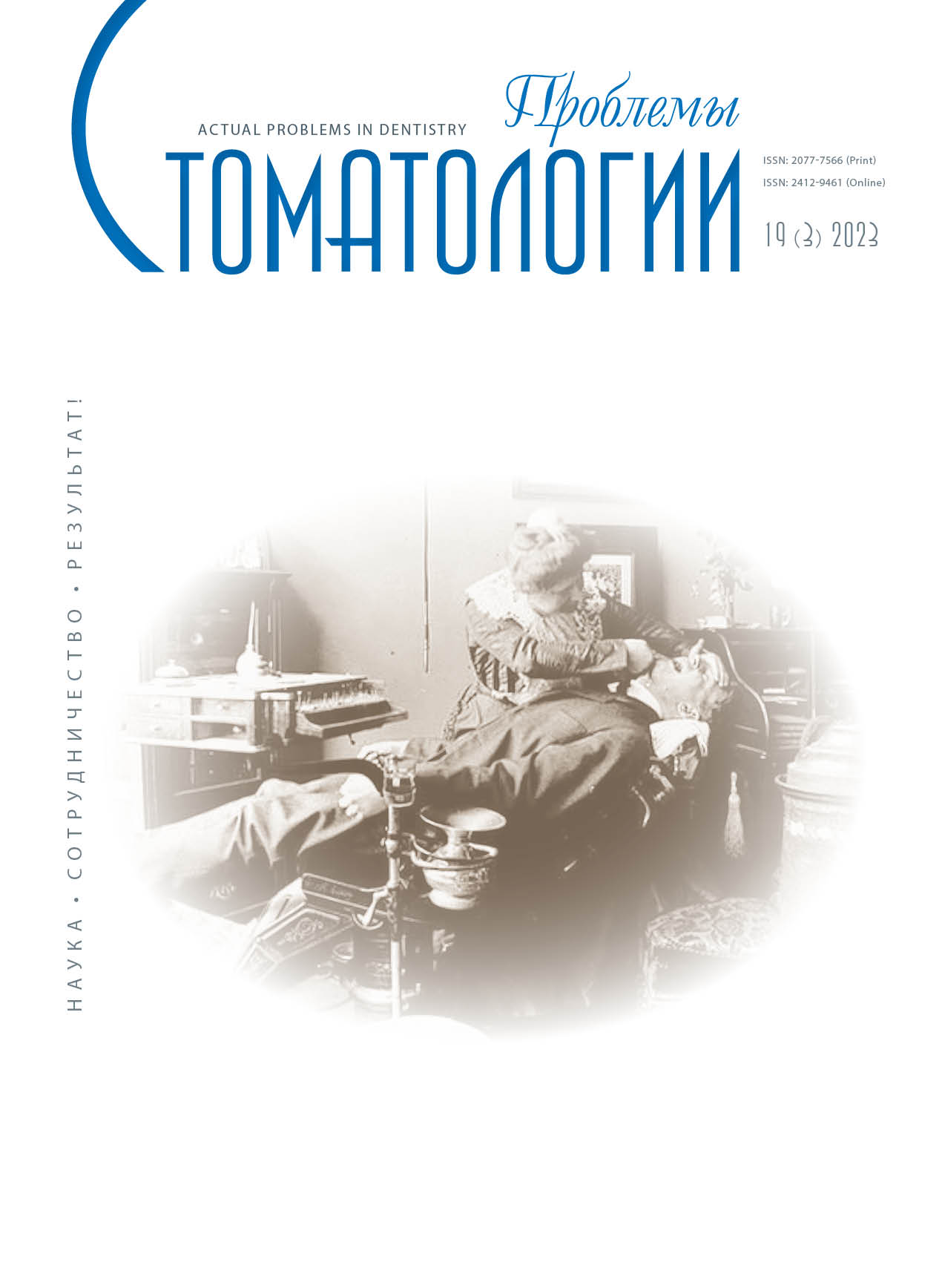from 01.01.2015 until now
Stavropol State Medical University (kafedra hirurgicheskoy stomatologii i chelyustno-licevoy hirurgii, assistent)
from 01.01.2023 until now
Stavropol, Stavropol, Russian Federation
City Clinical Emergency Hospital
Stavropol, Stavropol, Russian Federation
Stavropol, Stavropol, Russian Federation
Stavropol, Stavropol, Russian Federation
Stavropol, Stavropol, Russian Federation
UDC 616
CSCSTI 76.29
Subject. The stages of medication-related osteonecrosis of the jaws (MRONJ) are an important criterion for choosing treatment tactics, while laboratory diagnosis of the stages of MRONJ has not been developed. The aim of the study is to analyze the dependence of the levels of bone metabolic markers (BMM) on the stage of the disease in patients with MRONJ. Methodology. The study included 48 cancer patients with osteonecrosis of the jaws while taking osteomodifying agents (OMA) with stabilization of the underlying disease. The activity of osteosynthesis was assessed by the level of osteocalcin (OC), osteoresorption – C-terminal telopeptide (CTX) – in the blood serum before treatment. The stage of MRONJ was established according to the classification developed at the Department of Surgical Dentistry and Maxillofacial Surgery of Stavropol State Medical University (2017). The levels of BMM indicators were compared for clinically significant stages (1, 2, 3) using the Kruskal–Wallis test for p < 0.05. Results. Stage 1 MRONJ was established in 17 (35.42%) patients, stage 2 – in 25 (52.08%) patients, stage 3 – in 6 (12.5%) patients. The average values of BMM indicators were: in patients with stage 1 – OK – 14.65 (10.5;17.5) ng/ml, CTX – 0.289 (0.172;0.351); with stage 2 OK – 10 (8.74;11) ng/ml, CTX – 0.137 (0.09;0.18); with stage 3 – OK – 15.5 (14;21) ng/ml, CTX – 0.476 (0.353;0.633). The average OC values were statistically significantly different in groups of patients with different stages of MRONJ (H = 14.13; p = 0.00085; p < 0.05), as were the STX values (H = 22.3; p = 0.00001; p < 0.05). At the same time, the average levels of both BMM in patients with stage 2 were lower than in patients with stage 1, and their highest level was recorded in stage 3 of the process. Conclusions. A significant (p < 0.05) relationship was established between the levels of OC and CTX and the stage of MRONJ: the maximum values were recorded at the third stage, the minimum at the second and intermediate at the first.
osteomodifying agents, medication-related osteonecrosis of the jaws, osteocalcin, C-terminal telopeptide, laboratory diagnosis
1. Di Fede O., Panzarella V., Mauceri R., Fusco V., Bedogni A., Lo Muzio L., SIPMO ONJ Board, Campisi G. The Dental Management of Patients at Risk of Medication-Related Osteonecrosis of the Jaw: New Paradigm of Primary Prevention. Biomed. Res. Int. 2018; 2018: 2684924. doi:https://doi.org/10.1155/2018/2684924.
2. Ruggiero S.L., Dodson T.B., Aghaloo T., Carlson E.R., Ward B.B., Kademani D. American Association of Oral and Maxillofacial Surgeons' Position Paper on Medication-Related Osteonecrosis of the Jaws-2022 Update. J. Oral Maxillofac. Surg. 2022; 80(5): 920-943. doi:https://doi.org/10.1016/j.joms.2022.02.008.
3. Limones A., Sáez-Alcaide L.M., Díaz-Parreño S.A., Helm A., Bornstein M.M., Molinero-Mourelle P. Medication-related osteonecrosis of the jaws (MRONJ) in cancer patients treated with denosumab VS. zoledronic acid: A systematic review and meta-analysis. Med Oral Patol Oral Cir Bucal. 2020; 25 (3): 326-336. doi:https://doi.org/10.4317/medoral.23324.
4. King R., Tanna N., Patel V. Medication-related osteonecrosis of the jaw unrelated to bisphosphonates and denosumab-a review. Oral Surg. Oral Med. Oral Pathol. Oral Radiol. 2019; 127(4): 289-299. doi:https://doi.org/10.1016/j.oooo.2018.11.012.
5. Ahdi HS, Wichelmann TA, Pandravada S, Ehrenpreis ED. Medication-induced osteonecrosis of the jaw: a review of cases from the Food and Drug Administration Adverse Event Reporting System (FAERS). BMC Pharmacol Toxicol. 2023 Mar 6;24(1):15. doi:https://doi.org/10.1186/s40360-023-00657-y.
6. Campisi G., Bedogni A., Fusco V. Raccomandazioni clinico-terapeutiche sull’osteonecrosi delle ossa mascellari (ONJ) farmaco-relata e sua prevenzione. - Palermo (Italy), 2020. - 234 p. (In Italian). https://tinyurl.com/spmo20
7. Japanese Allied Committee on Osteonecrosis of the Jaw, Yoneda T., Hagino H., et al. Antiresorptive agent-related osteonecrosis of the jaw: Position Paper 2017 of the Japanese Allied Committee on Osteonecrosis of the Jaw. - J Bone Miner Metab. 2017; 35 (1): 6-19. doi:https://doi.org/10.1007/s00774-016-0810-7.
8. Kim J.W., Kwak M.K., et al. Medication related osteonecrosis of the jaw: 2021 position statement of the Korean Society for Bone and Mineral Research and the Korean Association of Oral and Maxillofacial Surgeons. J Bone Metab. 2021; 28 (4): 279-296. doi:https://doi.org/10.11005/jbm.2021.28.4.279.
9. Russian public “Society of specialists in maxillofacial surgery”. Inflammatory jaw diseases: clinical guidelines for maxillofacial surgery. https://tinyurl.com/guidek102
10. Ebzeev A.K. Bisphosphonate-related osteonecrosis of the jaw (BRONJ) in cancer patients. Kazan medical journal. 2020; 101 (2): 226-231. doi:https://doi.org/10.17816/KMJ2020-226.
11. Khan A.A., Morrison A., et al., International Task Force on Osteonecrosis of the Jaw. Diagnosis and management of osteonecrosis of the jaw: a systematic review and international consensus. J Bone Miner Res. 2015; 30 (1): 3-23. doi:https://doi.org/10.1002/jbmr.2405.
12. Schubert L., Russmueller G., Lagler H., Tobudic S., Heindel E., Kundi M. [et al.] Bone turnover markers can predict healing time in medication-related osteonecrosis of the jaw. Support Care Cancer. 2021; 29(12):7895-7902. doi:https://doi.org/10.1007/s00520-021-06361-z.
13. Peisker A., Raschke G.F., Fahmy M.D., Guentsch A., Roshanghias K., König K.C., Schultze-Mosgau S. Cross-Sectional Study of four Serological Bone Turnover Markers for the Risk Assessment of Medication-Related Osteonecrosis of the Jaw. J Craniofac Surg. 2018; 29(2): 137-140. doi:https://doi.org/10.1097/SCS.0000000000004224.
14. Demircan S., Isler S.C.. Changes in serological bone turnover markers in bisphosphonate induced osteonecrosis of the jaws: A case control study. Niger J Clin Pract. 2020; 23(2): 154-158. doi:https://doi.org/10.4103/njcp.njcp_374_19.
15. Traboulsi-Garet B., Jorba-García A., Camps-Font O., Alves F.A., Figueiredo R., Valmaseda-Castellón E. Is serum C-terminal telopeptide cross-link of type 1 collagen a reliable parameter for predicting the risk of medication-related osteonecrosis of the jaws? A systematic review and meta-analysis of diagnostic test accuracy. Clin Oral Investig. 2022; 26(3): 2371-2382. doi:https://doi.org/10.1007/s00784-022-04383-3.
16. 5. Bagrova S.G., Basin E.M., Valiev A.K., Den'gina N.V., Kopp M.V., Kutukova S.I. [et al.] Prevention and treatment of bone pathology in malignant neoplasms. Malignant tumours. 2021; 11(3s2-2):39-54. (In Russ.) doi:https://doi.org/10.18027/2224-5057-2021-11-3s2-38.
17. Spevak E.M., Khristoforando D.Yu., Ivanyuta S.O., Spevak R.S., Bodulina N.A. Terminology and classification of medication-related osteonecrosis of the jaws (review). Clinical Dentistry (Russia). 2023; 26 (2): 76-85 (In Russ.). doi:https://doi.org/10.37988/1811-153X_2023_2_76.




















